Día de los Muertos
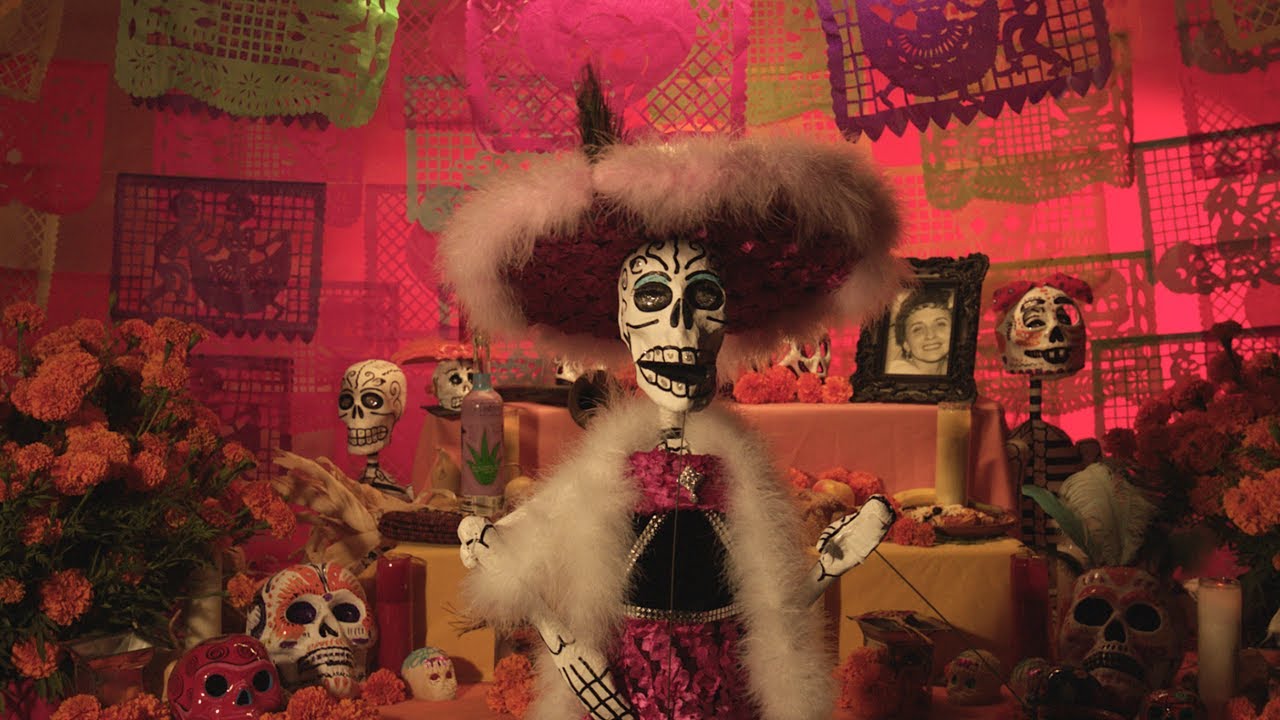
Today we are taking a break from Halloween to share with you another beautiful holiday that takes place this time of year. At Kidspace we love to connect and learn about each other, and that means hearing from and celebrating all the people on our team and in our community!
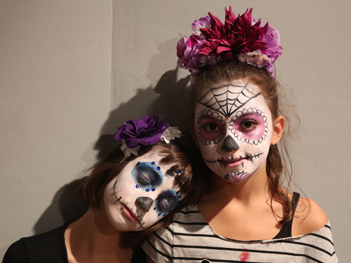
Even though it takes place close to the same time, Día de los Muertos is a unique holiday, very different and unrelated to Halloween. Across Latin America, Mexico, and the United States, on November first and second is the celebration of Día De Los Muertos, or Day of the Dead. It is a wonderful celebration of life that remembers those who have passed away by joyfully welcoming back the souls of loved ones and deceased ancestors through food, music, and tradition. It’s a special time that connects us with people we love.
In this blog, you’ll meet one of our Kidspace team members, Vince Dominguez, who has shared his Día de los Muertos Family Tradition and explained how he and his family celebrate each year. Then, we encourage you and your family to share and tell your own Family Stories with each other. Finally, we’ll show you how to make some tissue Paper Marigolds, if you would like to use them for a celebration at home.
My Día de los Muertos Family Tradition
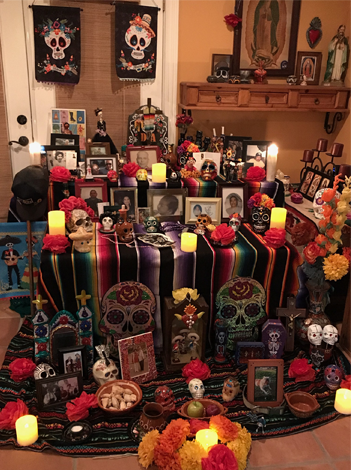 My first experience of loss was the passing of my father when I was a child. Instead of sheltering me from this, my mother decided to embrace the loss to teach me about life and used this celebration as a way to welcome his spirit back for a short time. I can remember putting our altars together and retelling stories of loved ones. We would laugh, we would cry, but most importantly we were remembering all the special people who have come into our lives to make us who we are today.
My first experience of loss was the passing of my father when I was a child. Instead of sheltering me from this, my mother decided to embrace the loss to teach me about life and used this celebration as a way to welcome his spirit back for a short time. I can remember putting our altars together and retelling stories of loved ones. We would laugh, we would cry, but most importantly we were remembering all the special people who have come into our lives to make us who we are today.
One of our major focuses of the celebration is the altar that is created to honor our loved ones who have passed. Our altar usually consists of three levels. For my family this represents the 3 stages of life: birth, life, and death. We drape the levels in vibrant tablecloths and begin to add the “ofrendas” and decorations.
These altars can be simple, but often, they are elaborately decorated in vibrant colors and wonderful images. The altars contain images of loved ones, candles, sugar skulls known as “calaveras” and most importantly, it is a place for “ofrendas” or offerings for those who have passed. These consist of some of the favorite things that the person enjoyed like specific treats or drinks. This is to welcome them and help aid them on their journey to and from the afterlife. My family has created these altars for as long as I can remember, and it has grown, as we have had to say goodbye to our loved ones throughout the years.
The bottom level usually contains candles, flowers, towels, and water. The candles are used to light the way back to us with the fragrance of the flowers enticing the spirits to come back. We lay out the towel and water so that they can refresh themselves after their long journey. The second level is where we place the food and special treats that they loved while they were here. The top level is where we place the images and personal belongings of those who have passed. Next to each image we try to include an item that belonged to them. For example, we place my father’s walking cane and favorite hat beside his photo. This helps us reconnect with the spirit in a physical form.
Along with these offerings we would often burn incense as we use it to cleanse and drive away bad spirits in preparations for your loved ones to return. Brightly colored tissue paper and decorations are hung on and around the altar as a representation of the celebration of life and is a reminder that this should not be a somber time, but one for celebration and welcoming home those you have missed.
Although the celebration usually occurs on the first and second of November, we tend to leave our altar up for a few more days as it can be hard to say goodbye. As we slowly start to take down the altar, it gives us the opportunity to say goodbye one more time and thank them for coming to visit us. This gives me peace and I look forward to feeling them again next year.
Death is scary and uncertain but can also be a very beautiful thing if we take the time to embrace it and show that it is all a part of life. Shortly after my father passed, I received a photo from my godmother of him holding me and my twin brother when we were babies. On the back read the words “To live in hearts we leave behind is not to die”. Never forget those you loved. They are with you and a part of you.
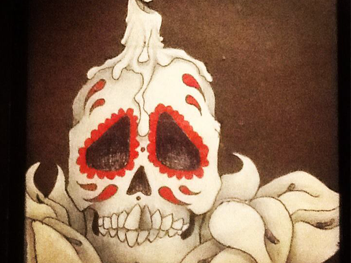 Throughout my life, these images have been a thread that is woven throughout the tapestry of my family. As an artist, Día de los Muertos images and altars have stuck with me and are greatly represented in my work. In this blog, you will see some examples of the altars that my family and I have created along with some of my artwork inspired by the holiday. I believe there is no wrong or right way to celebrate Día de los Muertos. You can celebrate your loved ones who have passed in any manner that is special to you. I can only speak on how my family has celebrated this event and what it means to me.
Throughout my life, these images have been a thread that is woven throughout the tapestry of my family. As an artist, Día de los Muertos images and altars have stuck with me and are greatly represented in my work. In this blog, you will see some examples of the altars that my family and I have created along with some of my artwork inspired by the holiday. I believe there is no wrong or right way to celebrate Día de los Muertos. You can celebrate your loved ones who have passed in any manner that is special to you. I can only speak on how my family has celebrated this event and what it means to me.
It’s important to hear and listen to other people’s stories. It helps introduce us to other perspectives, whether they are from a shared culture we are a part of, or one that is different from our own. It is a way to celebrate our differences, and often helps us see that we have more in common with others than we might think.
Does your family celebrate Día de los Muertos? Do you have a special way that you celebrate those who have passed? We would love to see your altars or any special celebrations of life that you and your family create!
 Sharing Family Stories
Sharing Family Stories
One special part of Día de los Muertos is celebrating loved ones by passing along oral history and family stories from one generation to the next. Sharing stories with each other is one way children create strong emotional bonds with their family. It builds a greater sense of connectedness to important people in their lives and can strengthen their sense of personal identity. Family storytelling also builds a foundation that improves communication between family members, and can even advance narrative and emotional skills outside of family conversations – especially when us adults respond to and engage with kids in the conversation.
Next time you have an opportunity to spend time (whether in person or virtually) with your loved ones and tell stories, here are some ideas on how to jog memories for the conversation:
- What is a time you had a really fun or silly time with someone in your family?
- What are some daily rituals that might feel special or make you remember something fun?
- Are there special places, or traditions, you have memories of enjoying with someone?
- Food is often something passed down among family members. What are some foods, recipes, or even restaurants that you remember sharing with someone?
- Are there songs, scents, books, or even movies and T.V that bring someone to mind for you?
- Is there a funny, happy, or memorable story you can remember about them?
Memories can be hard to think of on the spot, it might be that your family starts the practice of sharing memories as they bubble up! Memories can come from lots of places and through doing lots of things, like seeing a snack at the grocery store, smelling a certain scent, or even hearing a song on the radio! Use these moments to share with others.
 Paper Marigolds
Paper Marigolds
In addition to storytelling, another part of Día de los Muertos is creating ofrendas, altars or offerings that are set up by families to celebrated deceased loved ones. While every family’s ofrenda is unique, here are some things that are often included, and what they represent to many families:
- Water to quench the thirst
- Salt to season the food
- Bread to represent the food needed for survival – bread that is made special for Day of the Dead is called Pan de Muerto (Bread for the Dead)
- Candles to guide the spirits back home.
Ofrendas also include pictures of family members, and things like incense, candy, calaveras (sugar skulls), colorful paper decorations called Papel Picado, and flowers – especially marigolds. In this activity, we’ll use orange and yellow tissue paper to make marigolds to decorate an ofrenda with, or just to set out in honor of someone you love.
Supplies
- Several squares of orange and yellow tissue paper (each flower takes around 4 squares) for the flower petals
- Scissors
- Green pipe cleaners for the flower stems
Preparation
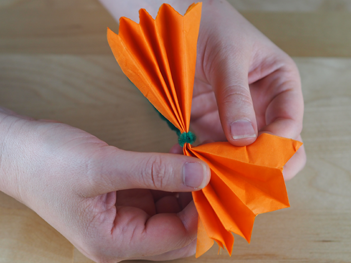 Cut tissue paper into same sized squares. We used tissue paper squares that were about 6×6 inches, but you can make flowers as big or small as you like!
Cut tissue paper into same sized squares. We used tissue paper squares that were about 6×6 inches, but you can make flowers as big or small as you like!
Directions
- Stack 4-6 squares of tissue paper on top of one another – they can be all orange, or orange and some yellow if you would like a multi-colored marigold .
- Fold the stacked squares, all together, into an accordion shape.
- Cut the tips off of each end to form a point or rounded petal, it’s up to you!
- In the center of the accordion, tightly wrap a pipe cleaner, twisting it to form the stem.
- Carefully pull apart and fan out each layer of the tissue paper to fluff out the sheets, forming them into the petals of a marigold.
This activity certainly supports and practices several cognitive and physical development skills, but mostly we hope it provides a way for you to share stories with each other, and find a way to celebrate those you love together.
We also encourage you to visit our friends over at the Museum of Latin American Art who helped us learn more, and have some wonderful resources on Día de Los Muertos.
To view all our Halloween blogs and more, click here.
 This program is supported, in part, by the Los Angeles County Board of Supervisors through the Los Angeles County Department of Arts and Culture.
This program is supported, in part, by the Los Angeles County Board of Supervisors through the Los Angeles County Department of Arts and Culture.

